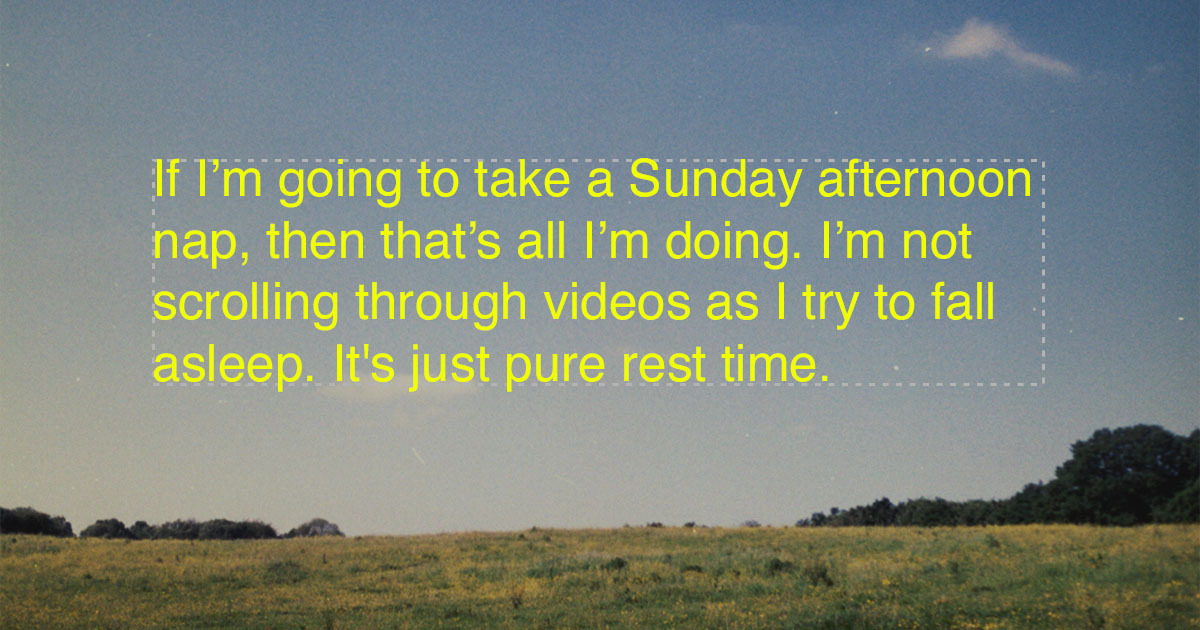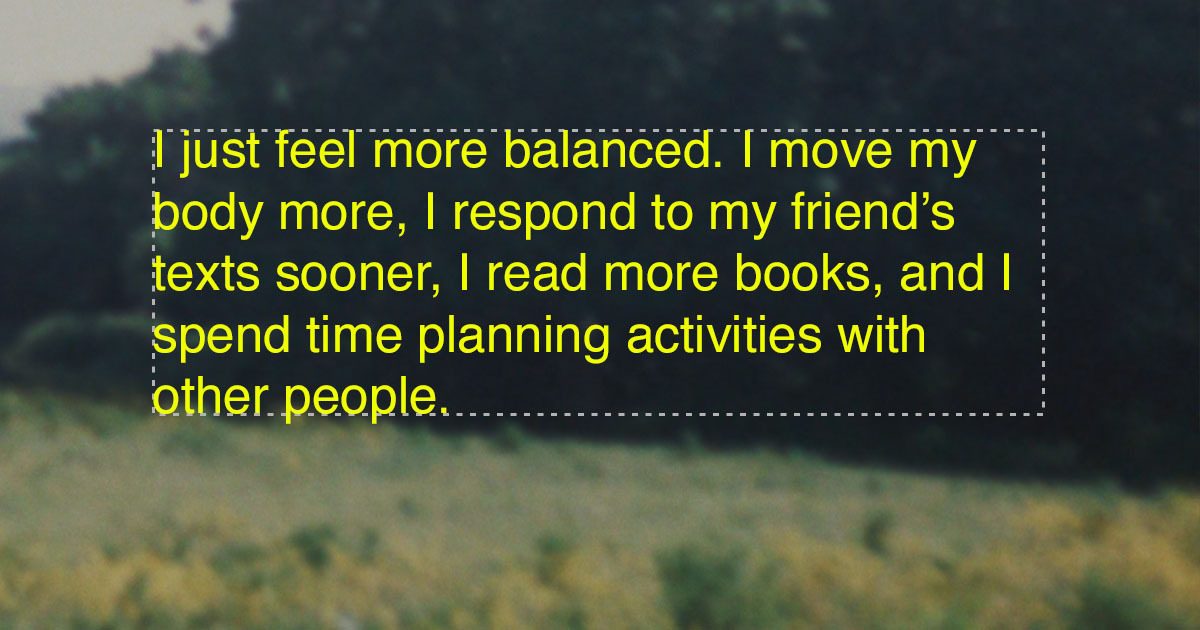At the start of Mental Health Awareness Month, we asked you to join us in a challenge, the Disconnect to Reconnect Challenge. For many, the challenge has come to a close—that includes four people from our team: Alex, Kayla, Lyssa, and (yes, another) Kayla. For two weeks, they all disconnected from social media in varying ways in hopes of reconnecting with themselves, with friends, with the physical world, and even with boredom and mental spaciousness.
We asked each of them to share what they noticed, what they felt, and how the challenge altered, whether subtly or noticeably, their mental well-being. Their relationships with social media are different. Their mental health journeys are different. And so, their responses are all different. That’s part of the magic of this challenge: it’s an individual assessment. It’s ultimately for you to uncover how social media hurts or uplifts you, how social media changes your brain space, and how social media plays a role in your existence—and the power you have to reclaim or gently adjust how you use and consume social media with your mental health at the center.
A reflection from Alex:
This spring, I’ve started practicing limiting the time I spend consuming social media. Specifically, I’ve designated Sundays as a day to disconnect from all the apps on my phone and the endless scrolling that comes with them. It’s not a hard and fast “no phone day” for me; I’m still checking in with friends, I’m still making sure I get all my daily puzzles done on the New York Times games app. It’s just a simple way for me to limit my scrolling and be a little bit more present in my life. It’s been a great stepping stone.
Since adopting this habit, I haven’t noticed a major shift in my life or anything. But there is a subtle quietness that has settled into place. What has stood out to me is that all of my activities are undiluted. If I’m going to take a Sunday afternoon nap, then that’s all I’m doing. I’m not scrolling through videos as I try to fall asleep. It’s just pure rest time. If I’m making food or working on an art project, then that’s it. I’m not using my phone as a buffer or to fill in the moments between steps. As is often the case with self-care and mental health care, it’s not a grandiose action that causes immediate change in my brain chemistry. But it is a chance to give my eyes and ears a break and let my mind have some breathing room.

A reflection from Kayla:
There is nothing more tempting to me on a hard day than to lie down in bed and scroll on social media for hours. If you asked me a while ago why this activity could captivate me so often and for so long, I would probably respond with something about the addictiveness of the algorithms, my desire to always know more about what’s going on in the world, and my love of silly memes that only the internet can provide. But now, after setting new boundaries and limiting my use, I think my answer is simpler. Scrolling on my phone for hours on end allows me to feel… numb. But the numbness doesn’t last. I started to notice how awful I felt after I scrolled social media for long periods: empty, dissatisfied, anxious, angry, and confused are just a few emotions that come to mind. I would look up from my phone, get out of bed, and feel disoriented. Like I was returning to a reality I forgot existed for a minute.
With this realization, I made the decision to take a break and set new boundaries for myself around my phone and the way I use it. I decided instead of just setting a time limit, I would set a different kind of boundary for myself, one that shows me what it looks like to prioritize mental health every single day. I made a list of all the daily “self-care” tasks that I know are beneficial to me, and decided that these things had to be done before I could even consider scrolling, as well as setting “no-use” social media times surrounding the morning and late evening.
Since implementing this new boundary, I’ve experienced days where the urge to crawl into bed and scroll is overwhelming. When those urges arise, I often sit, staring out the window—stubborn because I don’t want to break my boundary, but I also don’t feel like doing anything else. I’ve also experienced days where I feel so good, so accomplished, and so regulated that I don’t feel the desire to scroll at all. Most of the time, though, I just feel more balanced. I move my body more, I respond to my friend’s texts sooner, I read more books, and I spend time planning activities with other people. I still get my chance to indulge in all the internet has to offer, but now it’s just another moment in my routine rather than something all-consuming that feels far beyond my control.

A reflection from Lyssa:
This challenge has taught me that I actually have a much more balanced relationship with social media than I expected. I started with “Level 2” because of my inkling of the positive relationship I’ve thoughtfully developed over the last few years. I easily deleted Instagram in week 1 and Facebook in week 2.
What I noticed most is that I missed the people I connect with on these apps. I missed the small artists I’ve become fans of, bought art from, and now occasionally converse with online. I missed supporting old friends I’ve met along my journey of living all across the globe. I missed seeing their weddings, their toddlers, the concerts they attend, and the milestones I’m unable to be present for due to distance.
The thing is, I have been using social media the way I preach it should be used—for connection. Although I’ve actively been working on my relationship with social media for years, the surprise of that realization is what gets me. It’s reassuring to know that I’m able to step away if I want to or feel I need to for whatever reason. The work I’ve already done has enabled me to appreciate technology for its strengths without being consumed by it.
A reflection from Kayla:
Having deleted apps and put blocks on my phone the night before, I felt that starting the challenge the next day wouldn’t be so bad…until mid-morning on Monday. For context, I am someone who has ADHD. And I can admit that sometimes I use social media and my phone as a way to procrastinate, but what I didn’t realize was that I often use it to self-soothe or self-regulate whenever I find myself stuck mentally. Some people with ADHD have this experience where they find themselves frozen or stuck in a paralysis. Sometimes referred to as ADHD paralysis, task paralysis, and mental paralysis, along with a couple of different terms. This occurs when I am trying to work on a task but am struggling to do it. I know what I need to do, and I know I can do it, but there is something in my brain that halts me from moving forward. And when I find myself stuck in these moments, I often turn to my phone. When I found that I couldn’t turn to my phone on Monday, I immediately felt uncomfortable and bothered. Bothered that I used my phone so much to regulate my brain when there are probably better ways to do it. Uncomfortable because I had to sit with my feelings and frustrations. So Monday was a struggle, which turned into struggling on Tuesday, which turned into struggling on Wednesday.
Luckily, I saw my counselor that week, and she reminded me that being online or on your phone isn’t necessarily a bad thing; it can be of help sometimes. I often experience all-or-nothing thinking, but I try to challenge that by reminding myself it doesn’t have to be this way. I can move forward with grace and kindness for myself, knowing that it’s okay if things need to look different than what I planned. So in the spirit of kindness and grace, I let myself look at websites that didn’t really suck me into scrolling or make me feel crappy. I began to feel some relief.
Going into the rest of the challenge I kept off social media and the apps that I tend to doomscroll or get sucked into, but I allowed myself some room to be on my phone. Even just cutting back on social media, I noticed a difference. I’m a lot more aware of how often I pick up my phone, so I now try to extend those periods of time. My sleep is of a better quality. My eyes are less strained. My shoulders and neck feel less tight. And as for my ADHD? With the help of my counselor, I have a game plan on how to tackle my to-do lists and tricks on how to get out of those moments where I feel stuck. My disconnection hasn’t been “perfect,” and that’s okay. Making space for myself to flow and function is what matters.
If you didn’t take on the challenge, that’s okay. There’s no pressure. What we do want to remind you is that this challenge doesn’t disappear; the invitation remains. You can sign up whenever you choose to. Today, tomorrow, next month, or this summer. And if/when you do commit to taking a break, we’ll be with you every step of the way with daily encouragement, check-ins, and resources that will arrive right in your inbox each day.
Learn more and take on the challenge at twloha.com/reconnect. We’re rooting for you—online and offline.